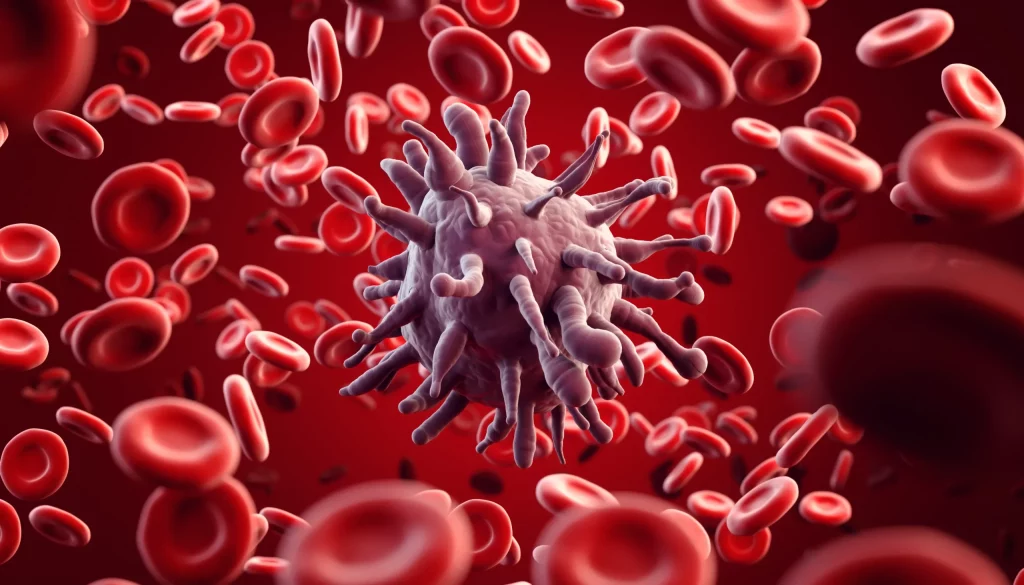
Table of Contents
Micrometastatic carcinoma has enormous significance in the realm of cancer research and treatment.
This medical terminology refers to the small spread of cancerous cells in groups that conventional imaging techniques often miss.
The fact that these tiny, stealthy invaders can manifest into full-blown, hard-to-treat cancer underscores the importance of addressing micrometastasis.
The journey of a patient grappling with micrometastatic carcinoma is akin to traversing a labyrinth filled with medical complexities and psychological stressors.
These patients face many challenges, from the fear of the unknown to the physical toll of rigorous treatment schedules.
Despite the odds, it is crucial to remember that medical advancements continually push the boundaries, paving the way for innovative solutions to combat micrometastatic carcinoma.
This piece outlines four steps to help patients navigate this labyrinth, armed with knowledge, grit, and hope.
Understanding Micrometastatic Carcinoma

We can liken micrometastatic carcinoma to invisible invaders, the Trojan Horse of cancer cells. They are microscopic clusters of cancer cells that spread silently and stealthily, often remaining undetected until multiplied.
Exploring the microscopic spread of cancer cells
- Stealthy Spread: Micrometastatic cells slither into the bloodstream or lymphatic system, hitching a ride to various body parts. These microscopic invaders sow the seeds for future cancerous growth, known as metastasis.
- Evading Detection: Due to their diminutive size, micrometastases often elude discovery until they have aggregated into more giant formations. It makes them a formidable enemy, as they can continue to increase undetected.
Detection Methods and Challenges
- Imaging Techniques: Traditional imaging techniques, like CT scans and MRIs, need help to detect micrometastases due to their minute size. Hence, they often fly under the radar, quietly spreading their harmful influence.
- Emerging Techniques: Researchers are conducting promising research into innovative detection methods, such as liquid biopsies, which can identify circulating tumor cells (CTCs) in the bloodstream.
Common Types of Cancers Prone to Micrometastasis
Certain types of cancers are especially susceptible to spreading through micrometastasis. These include:
- Breast Cancer: Micrometastatic spread is a common occurrence in breast cancer, particularly in the lymph nodes.
- Melanoma: This aggressive form of skin cancer frequently disseminates via micrometastasis, often leading to secondary tumors in the brain, liver, and lungs.
- Prostate Cancer: Prostate cancer cells can spread to the bones through micrometastasis, often resulting in painful bone metastases.
Despite the challenges posed by micrometastatic carcinoma, remaining hopeful is essential. The field of cancer research is continually evolving, bringing us closer to effective detection and treatment options for this stealthy enemy.
Early Detection and Diagnosis
Early detection and diagnosis stand as the first and most crucial step in overcoming the odds of micrometastatic carcinoma. The stealthy nature of this disease necessitates a proactive approach to health, one that involves regular screenings and utilizes the latest in medical imaging and research.
Importance of Regular Screenings
Regular screenings serve as the first line of defense in detecting micrometastatic carcinoma. Regular health monitoring increases the likelihood of detecting abnormalities at the earliest possible stage when the disease is most manageable. Routine screenings embody the adage: ‘An ounce of prevention is worth a pound of cure.’
Advanced Imaging Technologies
While traditional imaging techniques may struggle to detect micrometastases, advancements in medical technology have given rise to more sensitive alternatives. The advent of techniques such as positron emission tomography (PET) and single-photon emission computerized tomography (SPECT) has dramatically enhanced our ability to detect these tiny invaders. Although not yet universally available, these advanced imaging technologies offer a beacon of hope in the fight against micrometastatic carcinoma.
3. Biomarkers and Their Role in Early Identification
Naturally occurring molecules, genes, or biomarker characteristics play a pivotal role in the early identification of micrometastatic carcinoma. By signaling the presence of cancer cells, biomarkers can alert physicians to the existence of micrometastases before they multiply into larger, more dangerous formations. Research into novel biomarkers and the development of tests to detect them push the boundaries of early cancer detection, shedding new light on the shadows cast by micrometastatic carcinoma.
Innovative Treatment Approaches

Innovative treatment approaches are continually transforming the landscape of cancer care, offering new avenues of hope for patients grappling with micrometastatic carcinoma. Here, we delve into two groundbreaking advancements reshaping the fight against this stealthy enemy: targeted therapies for micrometastatic lesions and immunotherapy.
1. Targeted Therapies for Micrometastatic Lesions
With advancements in molecular biology and technology, scientists are now better equipped to understand the unique characteristics of individual cancers—knowledge that has paved the way for targeted therapies. This approach focuses on specific genes and proteins that are inherent to and drive the growth of cancer cells.
- Precision Medicine involves targeted therapies tailored to the patient’s genetic makeup, leading to a more personalized, effective treatment plan.
- Reduced Side Effects: Targeted therapies often lessen the side effects of traditional treatments, explicitly targeting cancer cells and sparing healthy ones.
2. Immunotherapy Advancements
Immunotherapy, a type of cancer treatment designed to boost the body’s natural defenses to fight cancer, has seen significant breakthroughs in recent years. It’s an innovative approach to handling micrometastasis, turning the patient’s immune system into a powerful adversary against cancer cells.
- Checkpoint Inhibitors: Checkpoint inhibitors disrupt the mechanisms cancer cells use to hide from the immune system, allowing it to recognize and attack these stealthy invaders.
- CAR-T Cell Therapy involves genetically engineering a patient’s immune cells to fight cancer. It has shown promising results in many cancer types, including those that spread via micrometastasis.
Innovation in treatment is a critical juncture in the fight against micrometastatic carcinoma. By harnessing cutting-edge science and technology, physicians can tailor treatments as unique as the patients they serve, bringing us ever closer to turning the tide against this formidable disease.
Lifestyle and Wellness Strategies
As we continue to explore novel therapies and advancements in the field of cancer care, it’s equally important to consider the role of lifestyle and wellness strategies in managing and preventing cancer. These factors, from nutrition to exercise and stress management, are critical in maintaining overall health and enhancing resilience against diseases, including cancer.
1. The Role of Nutrition in Cancer Prevention and Management
Proper nutrition is a cornerstone of cancer prevention and management. It equips the body with essential nutrients that boost the immune system, support cellular repair, and reduce inflammation.
- Balanced Diet: A balanced diet, rich in fruits, vegetables, lean proteins, and whole grains, can help to provide the necessary vitamins, minerals, and antioxidants that are vital for maintaining good health and preventing diseases, including cancer.
- Hydration: Adequate hydration is essential for flushing out toxins and maintaining optimal bodily function.
- Limit Processed Foods: Reducing the intake of processed foods and sugary drinks can minimize the risk of obesity, a known risk factor for several types of cancer.
2. Exercise and Its Impact on Cancer Resilience
Physical activity plays a vital role in enhancing cancer resilience. It can help to improve physical function, combat fatigue, and reduce the risk of cancer recurrence.
- Regular Activity: Engaging in regular physical activity, whether it’s walking, swimming, or yoga, can help to maintain a healthy weight and boost the body’s immune function.
- Strength Training: Strength training can enhance muscle mass and bone density, critical to improving the overall resilience.
- Flexibility Exercises: Flexibility exercises can enhance joint health and reduce the risk of injury, supporting overall physical well-being.
3. Stress Management for Overall Well-Being
Managing stress effectively is crucial to overall well-being and can have profound effects on one’s ability to cope with the challenges that a cancer diagnosis brings.
- Mindfulness and Meditation: Incorporating mindfulness and meditation into daily life can help to reduce stress and strengthen mental resilience.
- Adequate Rest: Ensuring sufficient sleep allows the body and mind to heal, rejuvenate, and cope better with stress.
- Social Support: Strong social support networks can provide emotional assistance, reducing feelings of isolation and stress.
Embracing these wellness strategies can contribute significantly to cancer prevention and management. Focusing on nutrition, exercise, and stress management can enhance our resilience, improve our overall health, and bolster our body’s natural defenses against disease.
Supportive Care and Survivorship

Surviving micrometastatic carcinoma is an empowering accomplishment that brings a new lease on life. However, the journey to recovery requires a holistic approach, incorporating comprehensive care plans, psychological support, and strategic navigation of life post-cancer.
1. Comprehensive Care Plans for Micrometastatic Patients
Comprehensive care plans are integral to managing micrometastatic carcinoma. These plans are tailored to the individual needs of each patient, factoring in their unique health situation, treatment history, and personal goals. They encompass medical treatments and supportive care measures to manage symptoms and side effects.
- Individualized Treatment: We meticulously design each care plan, incorporating the most suitable therapies, regular monitoring, and adjustments as necessary.
- Integrated Support: Care plans include nutritional guidance, physical therapy, and strategies to address potential side effects, ensuring patients remain strong and resilient during treatment.
2. Psychological Support and Coping Strategies
The psychological burden of a cancer diagnosis can be overwhelming, hence the importance of psycho-oncology. This discipline integrates psychological support into cancer care, helping patients cope with the emotional challenges that arise.
- Therapeutic Support: Counseling sessions and cognitive-behavioral therapy can aid in managing anxiety and depression, enhancing emotional resilience during treatment.
- Support Groups: Interaction with fellow survivors and patients can provide a sense of community and understanding, offering emotional solace during tough times.
3. Navigating Life After Micrometastatic Carcinoma
The journey doesn’t end with treatment; patients often face a new set of challenges as they navigate life post-cancer. Thus, survivorship care plans are crucial.
- Follow-up Care: Regular health screenings and check-ups are essential to monitor for recurrence and manage any long-term effects of treatment.
- Lifestyle Modifications: Adopting healthier lifestyle habits, including a balanced diet and regular exercise, can enhance overall well-being and reduce the risk of recurrence.
- Emotional Adjustment: As survivors reintegrate into their usual roles and routines, they may need emotional support to adapt. Counseling and support groups can continue to play a vital role in this phase.
Supportive care and survivorship focus on the whole person, not just the disease. They recognize that every patient’s journey is unique, and by addressing their physical, emotional, and psychological needs, we can truly support them in their fight against micrometastatic carcinoma.
Conclusion: Embracing the Journey towards Overcoming Micrometastatic Carcinoma
Determination, resilience, and comprehensive care strategies pave the journey to overcoming micrometastatic carcinoma. From prioritizing a balanced diet, regular exercise, and effective stress management to embracing comprehensive care plans, psychological support, and a proactive approach to life post-cancer, each step is crucial in enhancing our resilience and fortifying our body’s defenses.
Individuals do not embark on this journey in isolation. It is a collective effort involving patients, their support networks, and healthcare providers. By empowering patients and their support systems through knowledge, resources, and emotional support, we can collectively fortify their resilience against the physical, emotional, and psychological impacts of cancer.
The battle against micrometastatic carcinoma is ongoing, and we must continue to raise awareness, promote early detection, and support ongoing research in this area. By doing so, we enhance the quality of life for those currently battling this disease and contribute to future advancements that could lead to more effective treatments, better survivorship care, and, ultimately, a cure. Let’s remain steadfast in our commitment to overcoming this challenge because together, we are stronger.
You may be interested in reading 14 Diagnosed Bacterial Pneumonia Symptoms.


